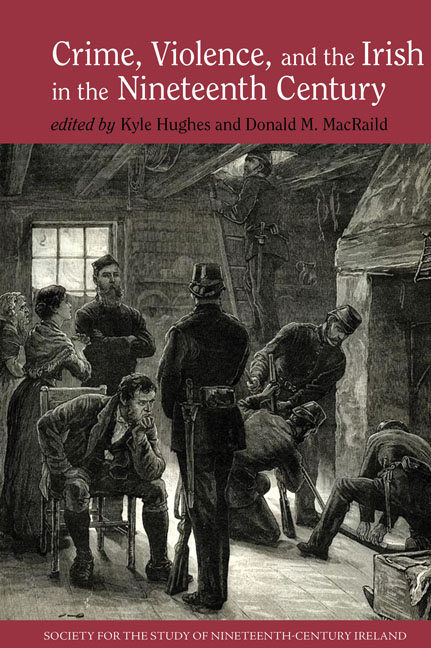Book contents
- Frontmatter
- Contents
- List of Illustrations
- List of Contributors
- Introduction: Crime, Violence, and the Irish in the Nineteenth Century; Themes and Perspectives
- Section 1 ‘Secret Societies’ and Collective Violence
- Section 2 The Law and its Responses
- Section 3 Sectarianism and Violence
- Section 4 Manifestations of Crime and Violence
- 11 Arson in Modern Ireland: Fire and Protest before the Famine
- 12 The Head Pacificator and Captain Rock: Sedition, Suicide, and Honest Tom Steele
- 13 ‘Skin the Goat's Curse’ on James Carey: Narrating the Story of the Phoenix Park Murders through Contemporary Broadside Ballads
- 14 Attitudes and Responses to Vagrancy in Ireland in the Long Nineteenth Century
- Index
12 - The Head Pacificator and Captain Rock: Sedition, Suicide, and Honest Tom Steele
from Section 4 - Manifestations of Crime and Violence
- Frontmatter
- Contents
- List of Illustrations
- List of Contributors
- Introduction: Crime, Violence, and the Irish in the Nineteenth Century; Themes and Perspectives
- Section 1 ‘Secret Societies’ and Collective Violence
- Section 2 The Law and its Responses
- Section 3 Sectarianism and Violence
- Section 4 Manifestations of Crime and Violence
- 11 Arson in Modern Ireland: Fire and Protest before the Famine
- 12 The Head Pacificator and Captain Rock: Sedition, Suicide, and Honest Tom Steele
- 13 ‘Skin the Goat's Curse’ on James Carey: Narrating the Story of the Phoenix Park Murders through Contemporary Broadside Ballads
- 14 Attitudes and Responses to Vagrancy in Ireland in the Long Nineteenth Century
- Index
Summary
The Clare landowner, marine engineer, and radical ‘honest Tom Steele’, a devoted follower of O'Connell, who gave him the title ‘Head Pacificator of Ireland’, tends to be remembered as a figure of fun given to bombastic oratory and slavish loyalty to the Liberator. He is presented in this light in the writings of O'Connell's Young Ireland critics, and this view of Steele was not confined to them. Henry Grattan Junior, son of the Patriot politician, once wrote in private that the only Protestant gentlemen willing to be led by O'Connell were ‘Mad Steele and a few others’. This chapter is a think-piece, drawing on sources which have not hitherto been used in accounts of Steele, namely reports in the London Tablet (run by the journalist Frederick Lucas, a convert to Catholicism from Quakerism who was one of the few English supporters of O'Connell's Repeal movement) and a journalistic profile of Steele written in 1869 by the Cork-born journalist Denis Holland, who as a young reporter had covered the Monster Meetings and the last years of O'Connell's political career.
This chapter argues, first of all, that Steele should be seen as representing a tradition of aristocratic radicalism whose exponents positively prided themselves on taking the side of ‘the people’ without receiving anything in return, as distinct from O'Connell's more modern style of political organisation and fundraising. Where O'Connell built much of his popular image on deliberate, transgressive shamelessness—on publicly scorning the honour code binding gentlemen, by forswearing dignity in manners and language when it suited him, by engaging in public and vitriolic insults while refusing to vindicate them on the duel-ground, by openly organising popular subscriptions to sustain his personal and political activities and shrugging off the taunt that this made him ‘the Big Beggarman’—Steele's refusal of financial and political rewards, his fighting duels to vindicate his status as a gentleman, even his intense deference to O'Connell and proclamations that he was a ‘Protestant Repealer’, could be seen as expressions of noblesse oblige by reaching down to those normally outside his honour group.
- Type
- Chapter
- Information
- Crime, Violence and the Irish in the Nineteenth Century , pp. 227 - 242Publisher: Liverpool University PressPrint publication year: 2017

